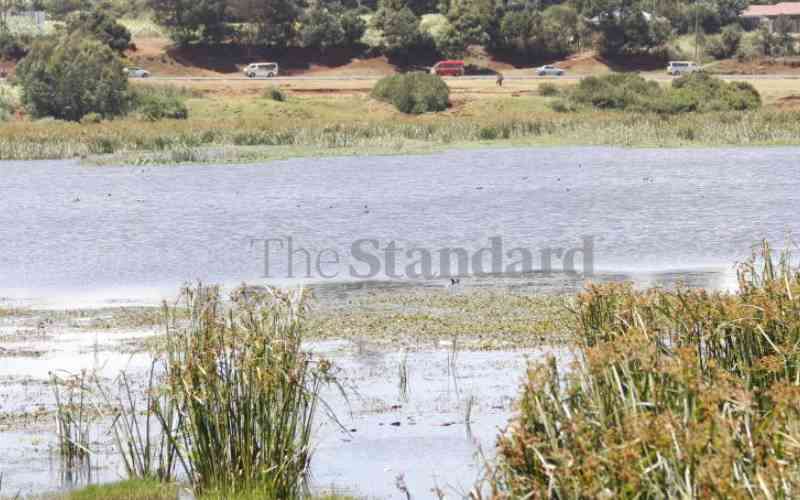
As the crisp Limuru highlands winds send the leaves into a gentle dance, birds perched in the trees chirp away in unison as if celebrating the tranquility of the clear bright morning.
On the ground underneath, the different tree species, small streams slowly gather speed as they roll down inclines to join rivers such as Karura, Ruaka, Riara and Kamiti.
These rivers originate from the pristine forests of the 133-square-kilometre Limuru Highlands Zone.
The rivers in turn feed the Athi River down in the plains. Millions of people, animals, birds, fish and microorganisms are nourished by these waters that complete this piece of biodiversity of the former exclusive White Highlands.
For generations, this circle of life remained unbroken, sustaining both flora and fauna. Besides the people of the highlands getting water from this ecosystem, residents of Nairobi have been dependent on it for decades.
As urbanisation spins out of control, the way to disaster is all mapped out. Uncontrolled development has been relentlessly chipping away at this ecosystem, threatening to reduce it into yet another concrete jungle comprising of buildings crazily thrown together.
“There is nothing wrong with development. What is dangerous is the failure to draw the connection between uncontrolled housing and environmental degradation,” says Njoki Wainaina, convenor, Limuru Highland Trust Information.
“The kind of development we are witnessing. It is a threat to the very existence of the highlands. Unless mitigation measures are put in place, the effects will be devastating in the long run.”
Environmental conservation
Nema Director General Boru Mamo observed that the Limuru Highlands Trust’s approach to sustainable development is a novel idea that will boost environmental conservation.

“Such integrated development plans should be embraced by counties as a means of stemming climatic change whose adverse effects are already being experienced locally and in the region,” he said.
The Trust was formed to create a legal framework for the implementation of the Limuru Highlands Zonal Spatial Plan for sustainable development.
Under the 2010 Constitution, the development of County Spatial Plans is a requirement for all 47 counties. The Limuru Highlands Plan is anchored on the Kiambu County Spatial Plan.
With most legal requirements in place, the Trust is setting out to engineer policy shifts to secure the future of more than 100,000 families and millions of Kenyans dependent on this water tower as well as other key interventions for sustainable development.
Ms Wainaina says the Trust’s move is informed by firsthand experience indicating that continued unplanned housing development is placing the area close to disaster with each passing year.
“First, you just need to witness what uncontrolled development has done to our freshwater supply. Most of the rivers and streams have been polluted because people are building without such requirements as sewerage disposal. This has created a situation where raw sewerage is emptied into rivers.”
This, she notes, is especially dangerous given the thousands of families that draw water for domestic use directly from the rivers and also downstream to the River Athi.
The situation is further aggravated by agro-based industries that have set up shops in areas that were initially earmarked for human settlements.
“Some of these industries that include flower farms empty their waste into rivers. We have commissioned research that has revealed rivers are increasingly getting contaminated with harmful substances that are silently poisoning our people,” says Ms Wainana.

Besides the pollution of streams and rivers, the ecosystem that generates the water is threatened with extinction by human activity.
The Limuru Highland Zone is home to over 1,600kms of wetlands including riparian areas and swamps which have been encroached by developers who are building on them without regard to their important role in sustaining life now and in the future.
“When buildings encroach and destroy riparian areas, you open the way for soil erosion and evaporation. The linkage between unplanned housing and water scarcity is evident in the area,” explains Ms Wainaina.
According to Ms Wainana, many high-rise buildings that have come in places such as Ruaka, have ignored some basic needs of residents and their families.
These include adequate, water supply, sewage disposal, children’s playgrounds and sunlight.
 The Standard Group Plc is a multi-media organization with investments in media platforms spanning newspaper print
operations, television, radio broadcasting, digital and online services. The Standard Group is recognized as a
leading multi-media house in Kenya with a key influence in matters of national and international interest.
The Standard Group Plc is a multi-media organization with investments in media platforms spanning newspaper print
operations, television, radio broadcasting, digital and online services. The Standard Group is recognized as a
leading multi-media house in Kenya with a key influence in matters of national and international interest.

